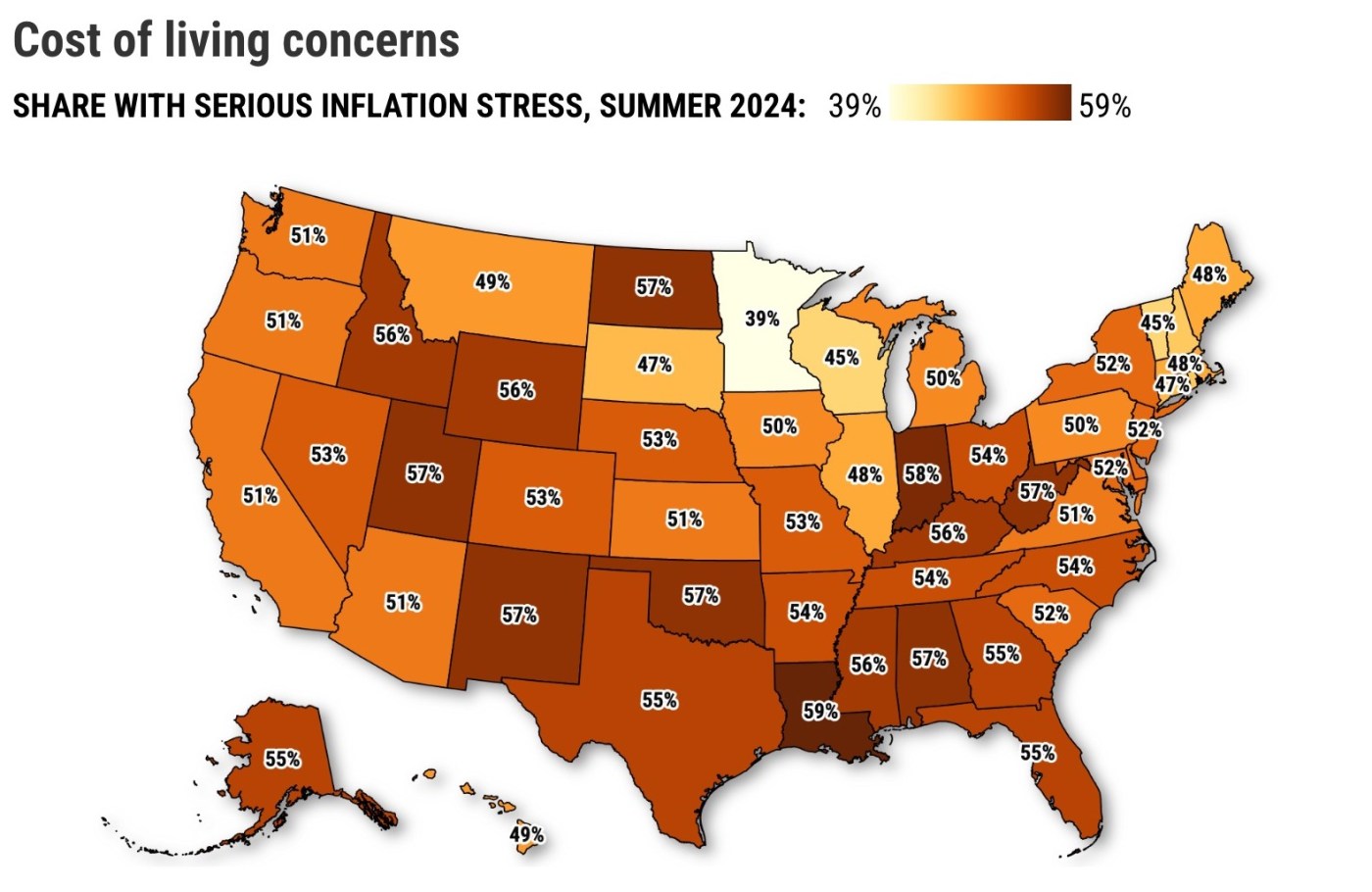We are just weeks away from the Federal Reserve announcing the war on inflation has been won.
Yet half of California might disagree, according to a regular Census Bureau survey that looks into the intersection of social and economic issues – including how prices affect consumer psyche.
In the past two-plus years, the nation’s central bank has used high interest rates to temper an overheated cost of living. The tactics seem to have worked as the official inflation rate has fallen from highs not seen in four decades in 2022 to essentially average levels this summer. So at the Fed’s September meeting, central bankers will likely begin lowering interest rates they control.
However, my trusty spreadsheet looked at the California slice of the survey and found 51% of those polled said increases in prices in the previous two months were “very stressful” or “somewhat stressful.” Additionally, 32% of Californians found it “somewhat difficult” or “very difficult” to pay for “usual household expenses in the last seven days.”
Now, this divide between Fed economists and a typical Californian’s wallet may be a matter of focus.
Yes, just about everyone agrees that the annual rate of growth in consumer prices is now muted. But nothing the central bank does can erase the roughly 20% jump in the cost of living in four years.
Those price hikes continue to be a major wallop to a typical California household budget – adding worry and stress to life in the already expensive Golden State.
This economic disconnect helps explain why California consumer confidence, at least as it is measured by the Conference Board, fell to a four-year low in September.
By the slice
What the census survey reveals is that one’s inflation viewpoint is likely tied to their financial strength. This is basically a have-vs.-have-not debate.
If the paycheck is plump, you have a shot at zigzagging around inflation. If it’s skimpy, well, good luck!
Ponder that 72% of Californians in households making $50,000 a year or less have significant inflation stress. And 54% of this low-paid slice of the Golden State say they had recent challenges paying the bills.
Conversely, consider California households earning $150,000 or more. Only 38% worry about inflation, with a mere 13% expressign bill-pay troubles.
That’s a stunning monetary spread, and it’s a theme running throughout the survey’s demographic slices.
Gender: Men typically earn more than women for a host of reasons. And 46% of California men have noteworthy inflation angst, with 29% in trouble with bills. But 55% of women polled in California have big inflation stresses, with 35% juggling payment challenges.
Age: The older you are, there’s typically greater financial security.
So, only 42% of 65-and-older Californians have inflation worries and 24% face bill-pay trouble. Compare that with the 49% of age 40-64 Californians with cost-of-living anxieties and 32% in bill-pay trouble.
And then there are the kids, the 18- to 39-year-old flock: inflation scares 57% of them, with 37% suffering payment headaches.
Education: Schooling is often tied to wealth generation. And this survey also has a degree gap.
The survey found 56% of lesser-educated Californians – folks with no more than a high school degree – have high cost-of-living stress and 39% are in trouble with bills. But only 47% of more-educated Californians – people who have some college experience, or more – are very troubled by inflation, with just 28% facing payment challenges.
It’s a family affair
Family status also conveys to financial stability. Contemplate what the survey tells us.
Marital status: 47% of married Californians have serious inflation fears, with 26% in bill-pay trouble. Those challenges jump to 56% of the not married group – divorced, widowed or single – with inflation worries and 39% having payment headaches.
Household size: Cost-of-living anxieties are lower when two Californians share a place. Only 43% of people in this living arrangement have cost-of-living worries, with 25% in bill-pay trouble. Let’s guess that most of these situations come with two incomes.
Inflation stresses jump to 51% in one-person households, with 30% in bill-pay trouble. And where three or more Californians are under one roof, 53% have inflation angst, with 35% having payment headaches.
Children: It’s a good guess that California’s larger families have kids – and added cost-of-living distress.
The survey found 54% of Californians living with children had high inflation apprehensions, with 38% in bill-pay trouble.
Yet, those with no kids? Just 48% had inflation angst, with 28% facing payment headaches.
Bottom line
The Fed is tasked with thankless chores that often require unpopular moves.
Think of all the folks angered by sharp hikes in interest rates, notably the real estate community. So the reversal of that policy without trimming previous price hikes will upset others, decidedly those still suffering inflation pains.
And cost-of-living consternation is not simply some quirky Golden State anguish. California’s 51% inflation worries ranked only 33rd highest among the states.
Louisiana had the highest anxieties at 59% of its population, then Indiana at 58% and Utah at 57%. California’s big economic rivals had lofty inflation fears, too: Texas was No. 13 at 55.3% and Florida was next at 55.1%. Smallest worry was in Minnesota at 39%, then Wisconsin at 48%, and Vermont at 45%.
As for bill-pay stress, California ranked No. 27 at 32% of its residents.
Tops was Mississippi at 42%, then Alabama at 39%, and Indiana and West Virginia at 38%. Texas was No. 11 at 34% and Florida was No. 7 at 36%. Lowest? Minnesota and Vermont at 24% and Massachusetts at 26%.
Jonathan Lansner is the business columnist for the Southern California News Group. He can be reached at jlansner@scng.com
Related Articles
Bay Area home sales up 19% from last July, as prices remain strong
Marin median house price dips to $1.6 million and sales rise
Would you pay $13,984 for 10-year-old Southern California car?
Bay Area wages jump 5.2%, largest increase on record
Walters: California unions trying to limit use of technology at the grocery store check-out line












